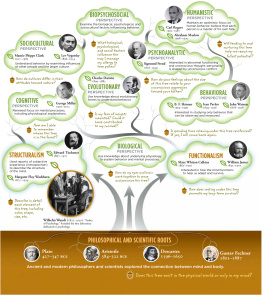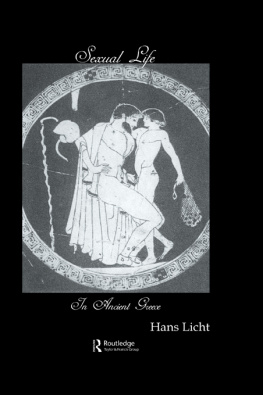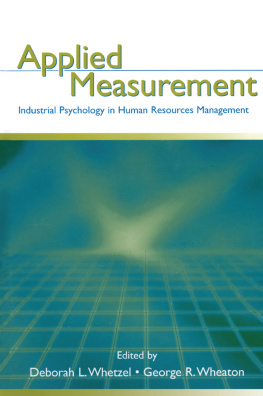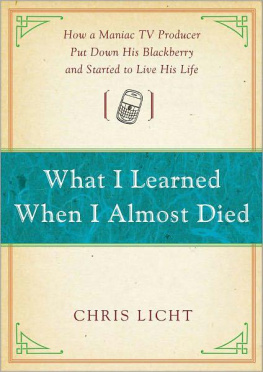Licht Deborah M - Psychology
Here you can read online Licht Deborah M - Psychology full text of the book (entire story) in english for free. Download pdf and epub, get meaning, cover and reviews about this ebook. year: 2017, publisher: Macmillan Learning, genre: Home and family. Description of the work, (preface) as well as reviews are available. Best literature library LitArk.com created for fans of good reading and offers a wide selection of genres:
Romance novel
Science fiction
Adventure
Detective
Science
History
Home and family
Prose
Art
Politics
Computer
Non-fiction
Religion
Business
Children
Humor
Choose a favorite category and find really read worthwhile books. Enjoy immersion in the world of imagination, feel the emotions of the characters or learn something new for yourself, make an fascinating discovery.
- Book:Psychology
- Author:
- Publisher:Macmillan Learning
- Genre:
- Year:2017
- Rating:3 / 5
- Favourites:Add to favourites
- Your mark:
- 60
- 1
- 2
- 3
- 4
- 5
Psychology: summary, description and annotation
We offer to read an annotation, description, summary or preface (depends on what the author of the book "Psychology" wrote himself). If you haven't found the necessary information about the book — write in the comments, we will try to find it.
Psychology — read online for free the complete book (whole text) full work
Below is the text of the book, divided by pages. System saving the place of the last page read, allows you to conveniently read the book "Psychology" online for free, without having to search again every time where you left off. Put a bookmark, and you can go to the page where you finished reading at any time.
Font size:
Interval:
Bookmark:

The vast knowledge base that defines the field of psychology is the result of rigorous and meticulous scientific research, most of which entails the careful collection of data. In the science of collecting, organizing, analyzing, displaying, and interpreting data.
A science that focuses on how to collect, organize, analyze, display, and interpret data; numbers that describe characteristics of a sample.Statistics are everywherenot just in the academic materials published by psychologists. Newspapers, websites, and television shows report on statistical findings everyday, though they sometimes make mistakes, exaggerate, or leave out important information. You can detect these types of errors if you understand statistics. It is important for everyone (not just psychology students) to think critically about how statistics are presented.
There are two basic types of statistics: descriptive and inferential. With descriptive statistics, researchers summarize information they have gleaned from their studies. The raw data can be organized and presented through tables, graphs, and charts, examples of which we provide in this appendix. We can also use descriptive statistics to represent the average and the spread of the data (how dispersed the values are), a topic we will explore later. The goal of descriptive statistics is to describe data, or provide a snapshot of what is observed in a study. Inferential statistics, on the other hand, go beyond simple data presentation. With inferential statistics, for example, we can determine the probability of events and make predictions about general trends. The goals are to generalize findings from studies, make predictions based on relationships among variables, and test hypotheses. Inferential statistics also can be used to make statements about how confident we are in our findings based on the data collected.
In if your knowledge of research methods is a little rusty.)
Mathematical procedures used to determine the likelihood that a researchers predictions are supported by the data collected.CONNECTIONS
In , we presented a study examining the impact of fast-paced cartoons on executive functioning. The researchers tested the following hypothesis: Children who watch 9 minutes of SpongeBob Square Pants will be more likely to show a decrease in cognitive function than children who watch an educational program or simply draw. The researchers used inferential statistics to determine that the children in the SpongeBob group did show a lapse in cognitive functioning in comparison to the other two groups in the study.
Suppose a researcher wants to determine whether taking vitamin D supplements can boost cognitive function. The researcher designs an experiment to test if giving participants vitamin D pills (the independent variable) leads to better performance on some sort of cognitive task, such as a memory test (the test score is the dependent variable). Participants in the treatment group receive doses of vitamin D and participants in the control group receive a placebo. Neither the participants nor the researchers working directly with those participants know who is getting the vitamin D and who is getting the placebo, so we call it a double-blind procedure . After the data have been collected, the researcher needs to compare the memory scores for the two groups to see if the treatment worked. In all likelihood, the average test scores of the two groups will differ simply because they include two different groups of people. So how does the researcher know whether the difference is sufficient to conclude that vitamin D had an effect? Using statistical procedures, the researcher can state with a chosen level of certainty (for example, with 95% confidence) that the disparity in average scores resulted from the vitamin D treatment. In other words, there is a slight possibility (in this case, 5%) that the difference was merely due to chance.
CONNECTIONS
In ). The researchers used a double-blind procedure to ensure that neither the participants nor the researchers expectations unduly influenced the results.
With the use of statistical methods, researchers can establish , indicating that differences between groups in a study (for example, the average scores for treatment and control groups) are so great that they are likely due to the researchers manipulations; the mathematical analyses suggest a minimal probability the findings were due to chance. When we use the experimental method (that is, randomly assign individuals, manipulate an independent variable, and control extraneous variables) and find statistically significant differences between our experimental and control groups, we can be assured that these differences are very likely due to how we treated the participants (for example, administering vitamin D treatment versus a placebo).
The probability that the findings of a study were due to chance.CONNECTIONS
In , we presented Banduras work on observational learning and aggressive models. Bandura and colleagues (1961) divided participants into treatment and control groups and found that the average expression of aggression for children who viewed aggressive models was statistically significantly greater than for the control group children who did not observe an aggressive model. The difference in the amount of expressed aggression for the two groups was large enough to be attributed to the experimenters manipulation as opposed to chance (for example, simply based on the children who were assigned randomly to each group).
In addition to determining statistical significance, we also have to consider the practical importance of findings, meaning the degree to which the results of a study can be used in a meaningful way. In other words, do the findings have any relevance to real life? If the vitamin D regimen produces statistically significant results (with a performance gap between the treatment and control groups most likely not due to chance), the researcher still must determine its practical importance. Suppose the two groups differ by only a few points on the cognitive test; then the question is whether vitamin D supplementation is really worth the trouble. We should note that big samples are more likely to result in statistically significant results (small differences between groups can be amplified by a large sample) even though the results might not provide much practical information.
Long before data are collected and analyzed, researchers must select people to participate in their studies. Depending on what a psychologist is interested in studying, the probability of being able to include all members of a population is not likely, so generally a sample, or subset of the population, is chosen. The characteristics of the sample members must closely reflect those of the population of interest so that the researcher can generalize, or apply, her findings to the population at large.
In an effort to ensure that the sample accurately reflects the larger population, a researcher may use random sampling, which means that all members of the population have an equal chance of being invited to participate in the study. If the researcher has a numbered list of the population members, she could generate random numbers on a computer and then contact the individuals with those numbers. Because the numbers are randomly picked, everyone on the list has an equal chance of being selected. Another approach is stratified sampling. A researcher chooses this method if she wants a certain variable to be well representedcar ownership in urban areas, for example. She divides the population into four groups or strata (no car, one car, two cars, more than two cars), and then picks randomly from within each group or stratum, ensuring that all of the different types of car ownership are included in the sample. Researchers use strata such as ethnicity, gender, and age group to ensure a sample has appropriate representation of these important factors.
Font size:
Interval:
Bookmark:
Similar books «Psychology»
Look at similar books to Psychology. We have selected literature similar in name and meaning in the hope of providing readers with more options to find new, interesting, not yet read works.
Discussion, reviews of the book Psychology and just readers' own opinions. Leave your comments, write what you think about the work, its meaning or the main characters. Specify what exactly you liked and what you didn't like, and why you think so.










